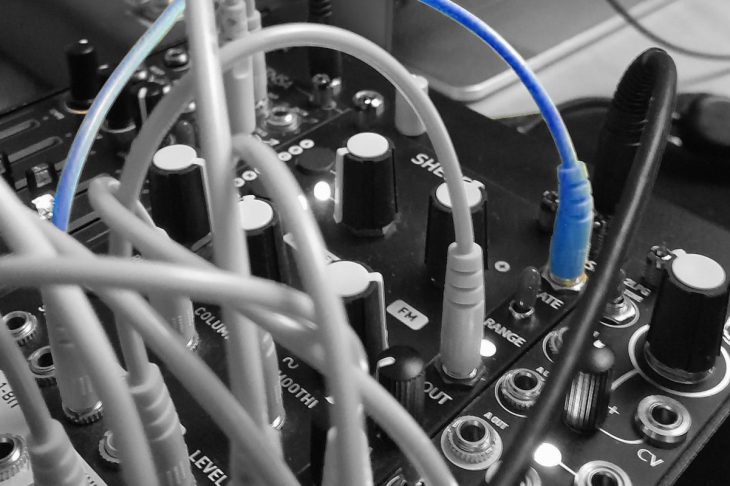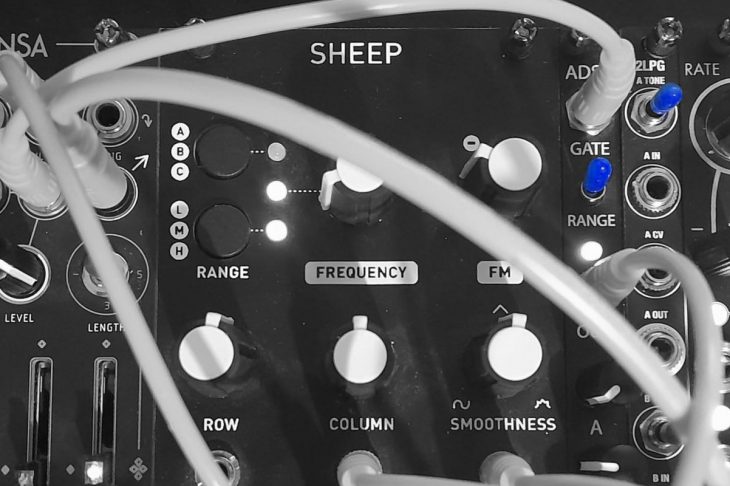Triple Mantis
Not sure what the plural of Mantis is, but I now have three of the Tip Top Audio cases of the same name, laid out end-to-end on my desk like a mini mission control.

Analog Synth Mantis
To the left is the Analog Synth Mantis which is probably the more ‘vanilla’ of the three cases. Built around three different oscillators (OSC303, Tip Top Z3000 and the Doepfer A-110), each with a separate, dedicated filter (VCF303, Intellijel uVCF and Doepfer A-105 respectively), as well as the usual array of VCA’s, ADSR’s and LFO’s (Mainly Doepfer or Erica synths modules).
Dinsync’s excellent Modseq module allows me to do some repeatable Sample and Hold style manipulation of the filter cut-offs, or paired with the Ladik Easy Quantizer module, makes a mean bassline sequencer for the OSC303.
Other modules of note include the FoH Choices joystick, which is paired with the clever little Ladik Joystick Math module which makes it a lot more flexible, and a small selection of Make Noise modules including the Moddemix and LXD which are both great for teasing out plucky, percussive sounds.
Digital & Sequencing Mantis
The middle, Digital & Sequencing Mantis has something of a split personality. The top row provides the master clock for the whole system, which I have distributed between the three cases using a combination of different powered multiples to create a semi-permanent clock backbone.
It also provides additional sequencing and quantizing capabilities, courtesy of a Turing Machine with the Pulses and Voltages expanders and the GMSN Pure Sequencer, both paired with Doepfer A156 Dual Quantizer. These are great when I want something a little more unpredictable than the ES-40 / Ableton Live combination or my Beatstep Pro. Alternatively, the sequencers work great as modulation sources for my percussion modules.
The lower row houses my ‘Digital’ modules, including the obligatory Mutable Instruments trilogy of Braids, Rings and Clouds, as well as Erica synths Black Hole DSP which has some lovely Shimmer effects. A Mutable Music Things ‘Ears’ module rounds things off, used primarily to trigger the strum input of Rings.
Gates & Percussion Mantis
Moving to the right we have the Gates & Percussion Mantis which has a wide variety of drum and percussion modules as well as gate triggers, clock dividers and logic modules which are great for coming up with abstract drum patterns.
The sound sources themselves include the ALM Taiko modules (Still on the lookout for the limited Haswell’s Taiko if one ever comes up on eBay or Muffwiggler), multiple kick drum synths (With the Hexinverter Mutant Bassdrum being a current favourite) and a selection of Tip Top Audio 808 modules.
It’s worth remembering that percussion modules don’t have to be limited to providing drum sounds though, as many have pitch CV inputs which allow you to use them for basslines and tuned percussion alike. They also often have built in VCA’s and envelopes, further increasing their effectiveness for a relatively low cost.
Also in this case are some additional effects courtesy of the Sara VCF filter from DinSync, ALM’s EQ and Music Thing’s Spring reverb module. There’s also a passive ring modulator I made with some germanium diodes which is pretty unique sounding.
And last but not least, we have the Audiodamage ADM09 USB audio interface which is normally linked to an iPad 3 running the stunning Borderlands 2, granular synthesis app. You can coax some amazing sounds out of Borderlands, particularly when feeding it a diet of modular synth noises from the ADM09.
One day, I might even learn what it all does 🙂 Seriously though, I’ve just signed up to the Learning Modular Patreon page which gives regular hints and tips on how to get the most out of your modular synth, as well as free access to a course of your choice on the main Learning Modular site. Can’t be bad!
I’d hope I’m comfortable with the basics, so went with the ‘Level 2 Eurorack expansion’ which is very comprehensive and appears to be regularly updated to keep it current. Chris Meyer who created and presents the course has a great knack of making complex concepts sound easy and I’m learning so much already. Here’s an excerpt from the course…
The only danger is that I’m now lusting after a Mordax Data module, having seen Chris demonstrate his one. I’m sure I can make it fit somewhere 🙂


